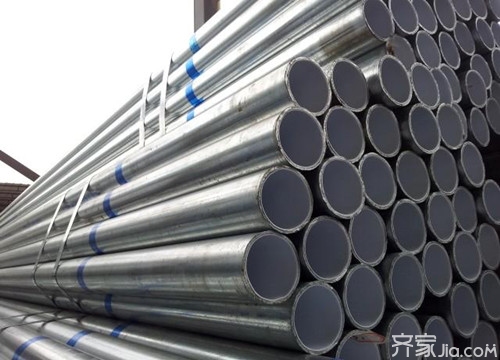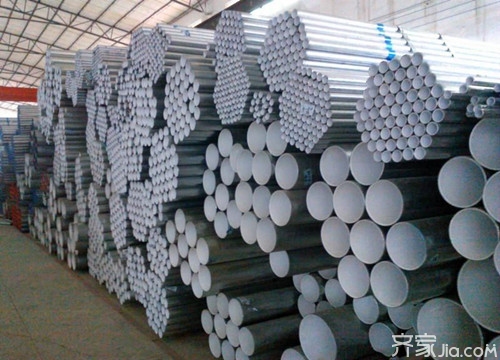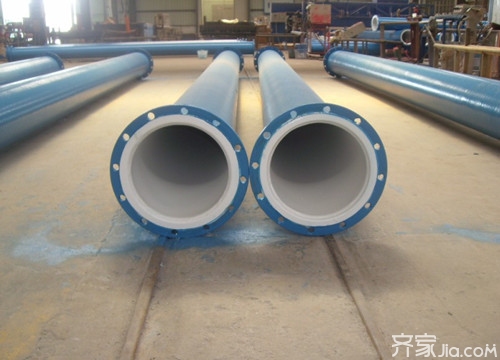The steel-plastic composite pipe is a composite pipe with a five-layer structure. The inner pipe is an HDPE pipe extruded continuously through an extruder. The inner layer is hygienic, non-toxic, non-polluting, has a smooth inner wall, does not foul, does not grow bacteria, and has fluid resistance. Small, small head loss advantages; outer PE layer anti-corrosion, anti-aging, excellent decorative effect. The following Xiaobian introduces the relevant knowledge of steel-plastic composite pipe and lining plastic pipe.

Steel-plastic composite pipe
Steel-plastic composite pipe, the product of seamless steel pipe, welded steel pipe as the base pipe, the inner wall of high adhesion, anti-corrosion, food-grade sanitary type polyethylene powder coating or epoxy resin coating. The pre-treatment, preheating, internal coating, leveling, and post-treatment processes for the galvanized inner plastic-coated composite steel pipe are upgraded products of the traditional galvanized pipe. The steel-plastic composite pipe is generally threaded.
Steel-plastic composite pipe introduction
The structure of the steel-plastic composite pipe is a new type of composite pipe and pipe, which is often referred to as steel-plastic pipe in many places. Steel is a kind of iron material. Plastic refers to plastic. The plastic in steel-plastic composite pipe is generally high-density polyethylene (HDPE).
There are many classifications of steel-plastic composite pipes, which can be classified into steel-reinforced steel-plastic composite pipes, seamless steel pipe-reinforced steel-plastic composite pipes, hole mesh steel-steel-plastic composite pipes, and steel wire mesh steel-plastic composite pipe according to the structure of the pipe. At present, the most popular steel on the market is steel-reinforced steel-plastic composite pipes, that is,
The steel-plastic composite pressure tube is often said, and the middle layer of the tube is a steel belt layer formed by butt-welding a high-carbon steel strip through curl forming. Both the inner and outer layers are high-density polyethylene (HDPE). The middle layer of the pipe is a steel belt, so the pressure performance of the pipe is very good, unlike the aluminum belt, the maximum diameter can only be 63mm, the maximum diameter of the steel pipe can be 200mm, or even larger; Because the steel strip in the middle layer of the pipe is closed, the steel pipe also has the function of blocking oxygen and can be directly used in the direct drinking water project. The inner and outer layers of the pipe are plastic materials and have very good corrosion resistance. Such excellent performance makes the use of steel-plastic composite pipes very widespread. Oil, natural gas transportation, industrial and mining pipes, drinking water pipes, drainage pipes and so on can be seen in various fields.
Lining steel pipe
Lining plastic steel pipe, galvanized seamless steel pipe, welded steel pipe as the base pipe, after the removal of welded ribs on the inner wall, lined with food-grade polyethylene (PE) pipe with equal diameter in the galvanized pipe, polyethylene liner thickness requirements in line with CJ/ T136-2007 standard, the final pressure heating after a certain period of time after molding, is an upgraded product of the traditional galvanized pipe.

The advantages and disadvantages of plastic-lined steel pipe
advantage
1, a wide range of applications, specifications complete:
As of 2013.6.19, in the construction water supply industry, the long-term use pressure of water supply pipes and fire-fighting pipe materials for high-rise buildings is approximately 1.6 MPa.
Therefore, the design pressure of the inner ribs-lined plastic-lined steel pipe can basically meet the pressure application requirements of the building water supply at 2.0 MPa, and this parameter is also an important parameter of the wall thickness design. The use temperature is also an important parameter of the pipe design, which determines the allowable stress of the material. In the industry, the temperature of the transport water is divided into cold water and hot water. The temperature of the cold water is generally 0°C to 25°C. However, the temperature of the medium in the surface-mounted pipeline is affected by the atmospheric temperature, and the summer temperature in southern China can be as high as about 40°C. Temperature can be lower than -40°C in winter, but water below 0°C will solidify into ice, which can not achieve the purpose of water. Therefore, there are some regulations for insulation in the industry, so that the temperature of the water in the pipeline is kept above 0°C to maintain the fluidity of the fluid. Hot water is generally used for heating and showering. The water temperature is usually below 75°C, and the instantaneous temperature can reach around 95°C. Based on the above investigations, the inner ribbed plastic-lined steel pipes are classified into cold water type and hot water type. The long-term use temperature of the cold water type is 0°C to 55°C, and the long-term use temperature of the hot water type pipe is 0°C to 75°C. °C, instantaneous temperature up to 95 °C.
2, the unique production process:
What kind of process is adopted after the product structure is determined is of vital importance in the economic activities of 2013.6.19.
It is directly related to the production cost and production efficiency of the product. At the same time, it also proposes the process requirements for the structural design and material selection of the product. The inner ribbed plastic-lined steel pipe adopts a unique mechanical drawing and compounding process, and the inner plastic pipe is pressed by the diameter reduction of the metal pipe, so that the two materials have permanent and reasonable interference, and the inner surface of the welded pipe is uniquely designed with the internal ribs. The embedding effect on the outer surface of the plastic pipe, as well as the physical and chemical modification of the plastic pipe before compounding, make the inner ribbed plastic-lined steel pipe have the technical features of no delamination, no shrinkage, and long-term use. And in 2001 won the national utility model patents. This unique process has high production efficiency, easy process control and high composite quality.
3, reliable and fast connection:
The connection between pipelines is the most important issue in the building materials industry. The connection strength is not reliable, it is not easy to install and maintain, and it can not adapt to the harsh natural conditions. These problems are the most concerned issues for users, design, construction and other units. . The inner ribbed plastic-lined steel pipe is deformed into a small-sized arc groove at a certain distance from the end face of the pipe by using the cold extrusion principle, and the snap ring stainless steel snap ring is put into the groove, and a nut or a sexual expansion interface is fitted. Enamel pipe fittings and accessories, can be tightened, quick installation. Due to the self-locking design of the tapered surface of the snap ring's mating part and the two-way sealed design with end-to-end and radial direction, it has a reliable connection strength and anti-leakage performance. At the same time, because all fittings adopt a detachable structure, combined with the use of special live fittings, it is extremely convenient for maintenance.
4, the outer surface of the anti-corrosion measures to improve:
As we all know, the corrosion of steel is very common, and the resulting economic losses are enormous.
We know that the corrosion of steel is mainly due to electrochemical corrosion, and the corrosion aging of plastics is mainly caused by chemical corrosion and ultraviolet radiation. The inner ribbed plastic-lined steel pipe is completely covered by the outer metal pipe because of the inner plastic pipe. Causes of corrosion aging, so that the plastic tube has a durable performance. The protection of outer metal pipes is much more difficult. Three layers of anti-corrosion measures are adopted on the outer surface of the inner ribbed plastic-lined steel pipe: the first layer is a galvanized layer, and the steel pipe forms a cathode for protection against rust. The second layer: epoxy primer, the formation of a dense polymer protective film on the surface of the galvanized layer, so that it is isolated from the air and water, slow down the oxidation corrosion of the zinc layer, thereby increasing the service life of the pipe. The third layer: topcoat, strengthen the protective effect of the film, improve the appearance of the product. When used in the ground, appropriate anti-corrosion measures are adopted to increase the service life of the system; it can also be used in the “internal rib-embedded double-sided lining plastic-steel pipe†with plastic pipe as the base pipe and outer surface covered with a layer of plastic pipe. PE pipe + carbon steel pipe + PP pipe products directly buried use.

5, pipe wall thickness is reasonable:
The wall thickness is an important parameter. The design formula of the pipe wall thickness given in Book 3 of the Mechanical Design Handbook is: S=PD/(2[δ]ψ)+C Where: S: Tube wall thickness (mm) P: medium pressure in the pipe (MPa); D: outer diameter (mm) of the pipe; [δ]: allowable stress (MPa) of the pipe at working temperature; j: longitudinal weld coefficient of the pipe, seamless steel pipe j = 1; Welded steel pipe j = 0.8; C: additional value of pipe wall thickness (mm); including manufacturing negative deviation C1; corrosion margin C2; thread depth C3; C=C1+C2+C3. The inner ribbed plastic-lined steel pipe determines the wall thickness of the welded pipe according to the above theory. The allowable stress [δ] of the pipe material is generally divided by the corresponding safety factor according to the strength of the material, and the minimum value is taken as the allowable stress of the material. The value is the allowable stress of the pipe material. At the same time, since the inner ribbed plastic-lined steel pipe adopts the snap ring type connection and the cold extrusion deformation groove, the value of the wall thickness C3 is not taken into account. Therefore, compared with the traditional galvanized steel pipe, the wall thickness is more reasonable and the economic potential has obvious potential.
Disadvantages : high cost, time-consuming installation, and can't completely solve the problem of water pollution caused by connecting parts
The above is the introduction of knowledge about steel-plastic composite pipes and plastic-lined steel pipes by Xiaobian. Please pay attention to Qijia information for more practical knowledge.
Steel tube metal tube
Welding magnets with on\off function and strong magnetic power for tacking or holding the workpiece as the clamps. The Switchable Welding Magnets are ideal for quickly temporarily holding steel work pieces to position in many industrial applications for their powerful magnetic force.
Advantages:
· Conveniently switchable operations
Strong magnetic powers


Switchable Welding Magnets
Switchable Welding Magnets,Customized Welding Magnet,Super Strong Magnet,Strong Welding Magnet
NINGBO SHINE MAGENETIC TECHNOLOGY CO.,LTD , https://www.shinemagnets.com